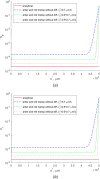Dynein Dysfunction Prevents Maintenance of High Concentrations of Slow Axonal Transport Cargos at the Axon Terminal: A Computational Study
- PMID: 36795013
- PMCID: PMC10158974
- DOI: 10.1115/1.4056915
Dynein Dysfunction Prevents Maintenance of High Concentrations of Slow Axonal Transport Cargos at the Axon Terminal: A Computational Study
Abstract
Here, we report computational studies of bidirectional transport in an axon, specifically focusing on predictions when the retrograde motor becomes dysfunctional. We are motivated by reports that mutations in dynein-encoding genes can cause diseases associated with peripheral motor and sensory neurons, such as type 2O Charcot-Marie-Tooth disease. We use two different models to simulate bidirectional transport in an axon: an anterograde-retrograde model, which neglects passive transport by diffusion in the cytosol, and a full slow transport model, which includes passive transport by diffusion in the cytosol. As dynein is a retrograde motor, its dysfunction should not directly influence anterograde transport. However, our modeling results unexpectedly predict that slow axonal transport fails to transport cargos against their concentration gradient without dynein. The reason is the lack of a physical mechanism for the reverse information flow from the axon terminal, which is required so that the cargo concentration at the terminal could influence the cargo concentration distribution in the axon. Mathematically speaking, to achieve a prescribed concentration at the terminal, equations governing cargo transport must allow for the imposition of a boundary condition postulating the cargo concentration at the terminal. Perturbation analysis for the case when the retrograde motor velocity becomes close to zero predicts uniform cargo distributions along the axon. The obtained results explain why slow axonal transport must be bidirectional to allow for the maintenance of concentration gradients along the axon length. Our result is limited to small cargo diffusivity, which is a reasonable assumption for many slow axonal transport cargos (such as cytosolic and cytoskeletal proteins, neurofilaments, actin, and microtubules) which are transported as large multiprotein complexes or polymers.
Keywords: axon; mathematical modeling; molecular motors; neuron; slow and fast axonal transport; α-synuclein.
Copyright © 2023 by ASME.
Figures

![Kinetic diagrams that depict various kinetic states in two models of α-syn transport in the axon and transitions between these kinetic states. (a) A diagram for the model with anterograde and retrograde motor-driven kinetic states (without cargo diffusion and pausing states). (b) A diagram for the full slow axonal transport model. The diagram is based on the model of SCa transport of neurofilaments developed in Ref. [38] with modifications to this model suggested in Refs. [39,40] to extend this model to cytosolic proteins transported in SCb. The full slow axonal transport model also includes degradation of free α-syn due to its destruction in proteasomes.](https://cdn.ncbi.nlm.nih.gov/pmc/blobs/1c5f/10158974/5048cd81005f/bio-22-1199_071001_g002.gif)




Similar articles
-
Bidirectional, unlike unidirectional transport, allows transporting axonal cargos against their concentration gradient.J Theor Biol. 2022 Aug 7;546:111161. doi: 10.1016/j.jtbi.2022.111161. Epub 2022 May 13. J Theor Biol. 2022. PMID: 35569529
-
Why slow axonal transport is bidirectional - can axonal transport of tau protein rely only on motor-driven anterograde transport?Comput Methods Biomech Biomed Engin. 2024 Apr;27(5):620-631. doi: 10.1080/10255842.2023.2197541. Epub 2023 Apr 17. Comput Methods Biomech Biomed Engin. 2024. PMID: 37068039
-
The Dynamic Localization of Cytoplasmic Dynein in Neurons Is Driven by Kinesin-1.Neuron. 2016 Jun 1;90(5):1000-15. doi: 10.1016/j.neuron.2016.04.046. Epub 2016 May 19. Neuron. 2016. PMID: 27210554 Free PMC article.
-
Distinct cytoplasmic dynein complexes are transported by different mechanisms in axons.Biochim Biophys Acta. 2000 Mar 17;1496(1):76-88. doi: 10.1016/s0167-4889(00)00010-0. Biochim Biophys Acta. 2000. PMID: 10722878 Review.
-
Cytoplasmic dynein and microtubule transport in the axon: the action connection.Mol Neurobiol. 1999 Oct-Dec;20(2-3):81-91. doi: 10.1007/BF02742435. Mol Neurobiol. 1999. PMID: 10966115 Review.
References
Publication types
MeSH terms
Substances
Grants and funding
LinkOut - more resources
Full Text Sources
Research Materials

